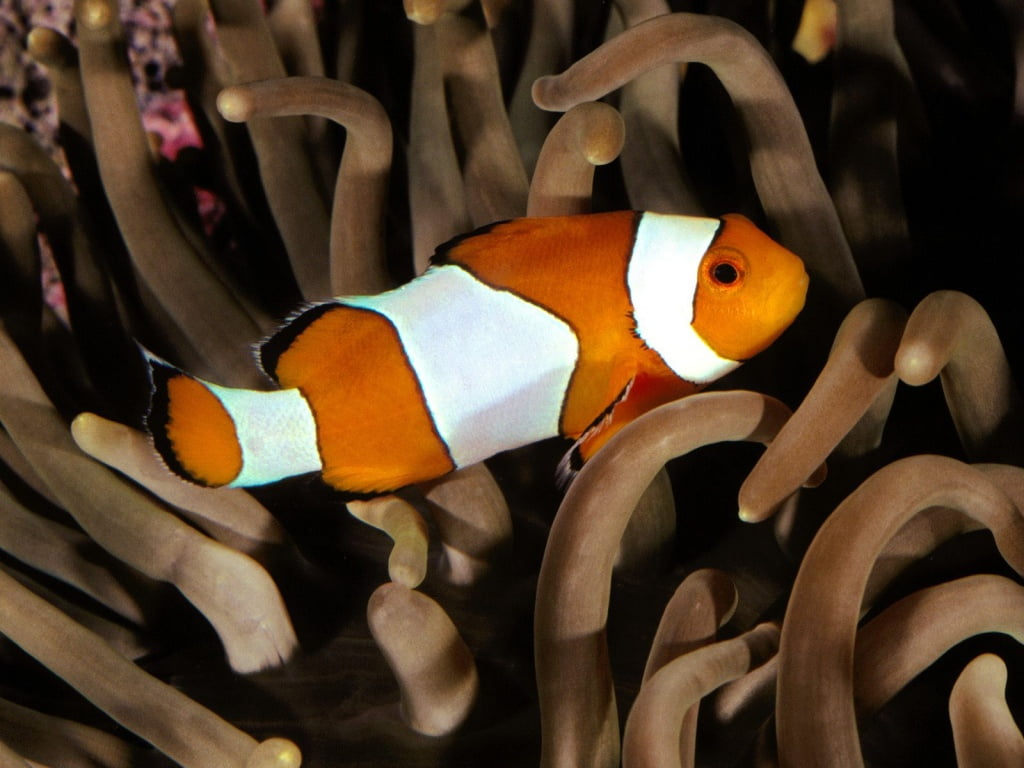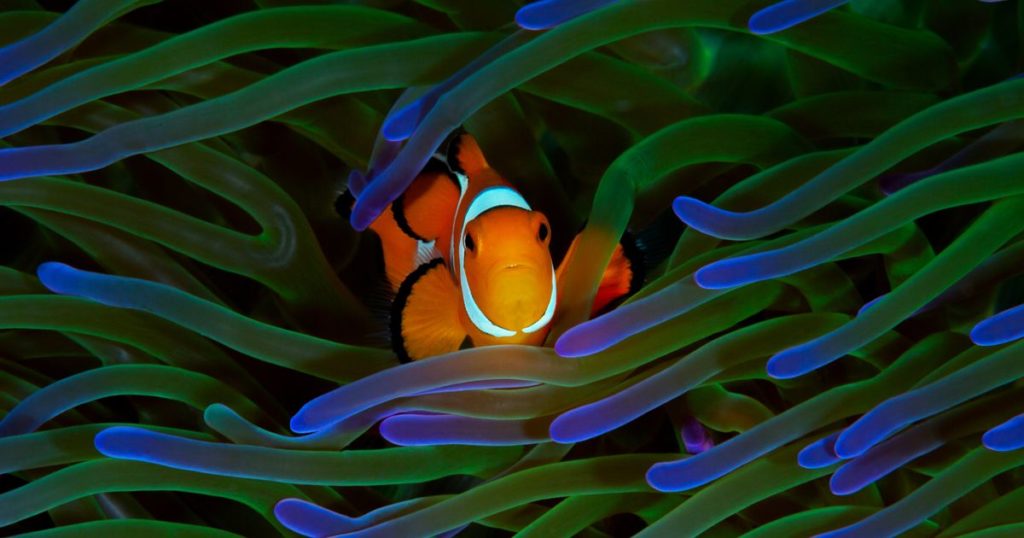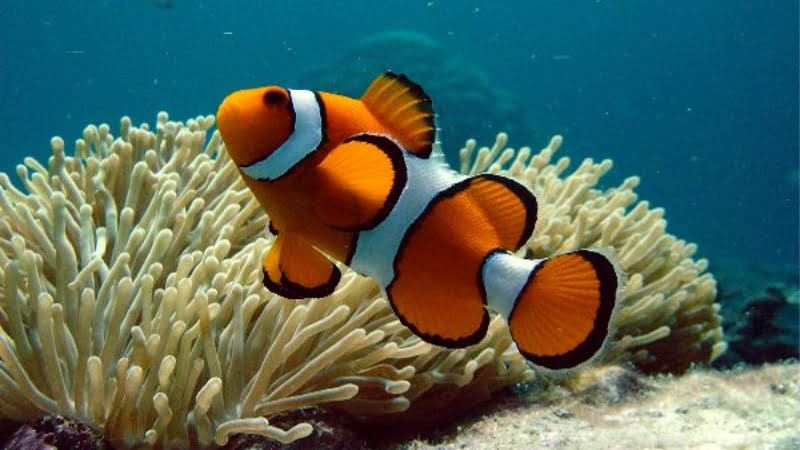Clownfish mating behavior is a topic that fascinates many people. It’s also something that clownfish enthusiasts might not be able to find the information they’re looking for on their own.
Clownfish are found exclusively in coral reefs, and their mating rituals have been a subject of much interest. This blog post will explore Clownfish mating behavior and clownfish reproduction, from courtship to laying eggs.
See also:
- Common Clownfish Behavior You Need To Know – Do They Fight?
- What Causes Are Clownfish Fighting? Don’t Worry Too Much
- 6 Things You Should Do To Deal With An Aggressive Clownfish
- Acclimating Clownfish: 5 Important Things You Should Know
Clownfish Mating Behavior & Offspring
Although little is known about fake clownfish mating habits, anemonefish behavior, in general, is well understood. Anemonefish are all monogamous. According to the ADW, the male constructs a nest by clearing space on a bare rock near the anemone before spawning. According to the Florida Museum of Natural History, he then courts a female with a display of expanded fins, biting, and chasing. He follows the female to the nest, but it is up to her to take the next step.
Before laying her eggs, she would make numerous passes over the nest. She will lay 100 to 1,000 eggs, each measuring 3 to 4 millimeters in length. After that, the male passes over the nest, releasing sperm to fertilize the eggs. The female then swims away.

According to the ADW, the male conducts most of the “egg sitting,” fanning them and eating any infertile or fungus-damaged eggs. Six to eight days later, the eggs hatch. The larvae float out and float for around ten days. They begin their lives transparent or translucent, but as they develop, they begin to take on the color of their species.
What Will Happens Clownfish Mating Behavior?
The adored sea creature is undergoing a process known as sequential hermaphroditism. If your understanding of clownfish is mainly based on Finding Nemo’s film, you might be shocked to find that Marlin should have been a female, and Nemo, the animated and endearing title character, should have been his partner.
The Process Clownfish Mating Behavior Of Sequential Hermaphroditism
To understand what went wrong in Finding Nemo, you must first understand sequential hermaphroditism. Hundreds of fish species go through this biological process, which is similar to a sexual transition. The clownfish, born entirely male, is arguably the most recognized (and adored) underwater hermaphrodite for scuba divers. Not all marine sequential hermaphrodites start as males; moon wrasses in the Indian Ocean and western Pacific, for example, all start as females and then become males, and some fish, like Asian sheepshead wrasse, spend several years as one sex (Asian sheepshead wrasses are born female) and then switch gender. The mangrove killifish is both male and female, and it self-fertilizes throughout its life. In reality, around 2% of fish species, or approximately 500 distinct species, exhibit some hermaphroditism.
Clownfish are equipped with both female and male reproductive organs. The female is the biggest fish in the clownfish population, which females dominate. She exclusively mates with the breeding male, generally the community’s second-largest and most aggressive male. The remaining members of society are sexually immature guys. When the female dies, the breeding male gets first to pick up the food and acquire weight, eventually becoming a female.
The biological alteration within the fish is driven by hormonal changes—chemical shifts that have a complicated and cascading effect,” explains Marah J. Hardt, Ph.D., founder, and CEO of OceanInk and author of Sex in the Sea. The testes disintegrate, and the ovaries develop in the transitioning man.
Hardt says that the mating male then “suppresses the development of youngsters in the anemone, so they are unable to compete with him for the one female.” This is accomplished by often subtle behavioral strategies, such as the breeding male grabbing the biggest portions of food to help him maintain his larger size.

In general, researchers aren’t sure why sequential hermaphroditism developed, although it’s assumed that clownfish’s preferred living arrangements had a role. These fish are homebodies, clinging to their cradle, a sea anemone with which they have a symbiotic connection. They may have developed as sequential hermaphrodites in order to be able to reproduce.
“Clownfish cannot afford to stray out to find a partner; there are just too many predators on the reef, making finding a date dangerous for clownfish,” explains Hardt. “As a result, they like to stick to their anemone habitats and team up with whoever happens to live there as well.”
What The Finding Nemo Story Got Wrong about Clownfish Mating Behavior?
So, let’s get back to Finding Nemo. Leaving home is the first mistake Nemo makes in Finding Nemo, but it’s not the first error the film’s makers make. Nemo’s mother, a Coral, gets eaten by a barracuda early in the film. Marlin, Nemo’s father, remains his father, although he should have been the new dominant female. Then, Nemo, the second-largest (really, the only) clownfish, would have taken over as the dominant male and the new female’s mate. As you can see, that would not have fit the narrative of a Disney-Pixar picture.
“In animals, egg number is unaffected by size. “No matter how short or tall, thin or big-boned we are, we are all born with about the same amount of eggs, and that number decreases as we age,” says Hardt. “In fish, this is not the case. In the case of fish, the larger the female, the more eggs she may deposit. And the link is exponential: a fish that doubles in size may lay ten times the number of eggs. So, by beginning as a male and then changing to a female when they reach maturity, clownfish maximize the number of eggs a female can produce. This is significant because clownfish require both parents to care for their eggs, which is not true of other fish species. But in clownfish, females lay eggs on the seafloor, and both the male and female must take turns to clean and guard them. So, there is a need for strong coupling; the two fish depend on each other. And if you are going to partner up, it’s best to have the bigger individual be a female to maximize egg (and thus, offspring) production. Sperm is inexpensive to produce. Therefore a little man may produce enough sperm to fertilize all of a large female’s eggs. This is why transitioning from male to female makes sense for clownfish—it works for their unique mating strategy.”
Hardt’s book Sex in the Sea discusses the mating activities of a variety of sea animals. She combines pop-culture imagery and modern parallels with scientific truths. Male blue whales, for example, “get their Barry White on” by generating deep baritone noises when seeking a female.
FAQs
How do you know when clownfish are mating?
Examine the tankmates’ actions. Usually, the female in a married relationship asserts her dominance by biting at the male’s fins.
What are the mating habits of clownfish?
Males attract females by courting. Courting behaviors include chasing, biting, and extending fins.
How long do clownfish take to mate?
Female clownfish grow sexually over the years, generally two years or more. Males, on the other hand, can start reproducing as early as six months.
Conclusions
You might be wondering how clownfish mating behavior. It is a time-consuming procedure that can take up to an hour! Clownfish dwell at less than 30 meters in the Indian and Pacific Oceans (100 feet). They usually reside in groups of one male clownfish and several female clownfish. The males congregate on the reef while the ladies swim between them. When they locate a partner, they stop floating around and are said to pair off.
Before mating, clowns would frequently change colors or dance to entice each other. If there are no companions around, the clowns may spin around for a bit until one appears!

Annette M. Chaney is an experienced marine biologist with over 20 years of experience as an aquarist and fishkeeper. She started her first aquarium at a young age, filling it with frogs and goldfish obtained from the ten-cent pet store.
Annette grew up caring for and breeding African Cichlids, which led to a hobby in high school that doubled as a profitable means. Attending Reed College gave her time to solidify herself as an accomplished aquarium caretaker with an eye for sales. After that, from 2009 – 2013, she studied at Roger Williams University – one of the most prestigious universities for Aquaculture and Aquarium in USA. She is the founder of AquariumCircle since 2010.
